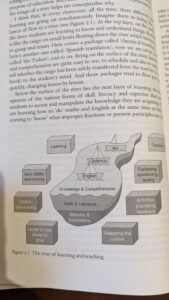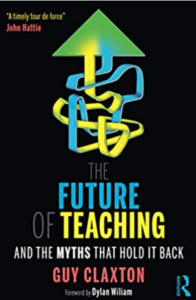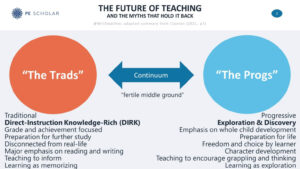“School is an institution that is deeply, systemically, designed for compliance. The whole apparatus of rules, punishments, timetables and bells, syllabuses and set texts, marking and examination requires and rewards the disposition of diligence, obedience, conscientiousness and correctness: of willingly doing what you are told regardless of whether it seems senseless or untimely. Student choice is systematically reduced to a low level. The margins for increasing student control and responsibility for what, when, where and how and why they learn are small and countercultural…” (Claxton, xxix)
This book, written by Guy Claxton, is in response to the growing voices, in the UK at least, for DIKR, or Direct Instruction in a Knowledge Rich curriculum. He is working to refute the research and claims of those in support of this more rigid pedagogical approach. In many ways, he is preaching to the choir with me, and this book serves to remind, provoke and support a diverse pedagogical approach that respects students’ and where they are at. It reminds me of all the great reasons WHY I believe in education as a force for positive change in the world.
You would be interested in this book if you were looking to:
(1) Deepen your understanding of different pedagogical approaches and their merits
(2) Access research on why and how education is an exercise in character, and is value laden
(3) Reflect on the role of an educator, in a system of education, and (as the quotation above signals) the generative tension that exists, and…
(4) Consider the opportunities that this generative tension provides
The book is structured in a way that the author is able to take on, directly, the myths holding back the future of learning, propped up by the DIKR voices. These areas are:
- Values
- Knowledge
- Thinking
- Learning
- Memory
- Teaching
In each section, Claxton uses effective research and rhetoric to debunk myths, such as the lecture being the most effective way for students to learn, and this, which I personally found almost comical:
Sipping water when you weren’t actually thirsty turned out to have a negative effect on learning…the presumption that the reason for doing these things [such a mandatory, schedule sipping of water!] was to make traditional learning more efficient remained” (77)
To that end, this book is a direct response to the claims made, and since I don’t subscribe to the claims or research of the DIKR lobby, at times the rhetoric wore me down.
Where I took much value from the book, was in exploring some of the analogies and approaches that the author outlined very effectively to deepen my thinking and understanding of my WHY.
For example:
I think I’ll conclude this chapter [on knowledge] with a quote from David Perkin’s Future Wise. It sums up several of the misgivings which we have been discussing.
“For basic education, expert amateurism is more important than expertise. Educational resources should go toward building a robust, flexible understanding of fundamentals, which demonstrably even good student generally don’t attain, more than advancing students rapidly toward sophisticated aspects of a discipline that rarely come up in the lives learners are likely to live.”
(Claxton, 52)
This definitely makes we want to pick up “Future Wise”, and the idea of amateurism is one that I believe and lobby for both in our students and in our educators, and especially in our schools of education. To have incoming teachers take a stance of expert amateurism, heightens not only their curiousity about the curriculum that they are training to teach, but of their students as well. It would prompt so many great questions about each lesson and unit design. Questions, that Claxton’s book raises time and again.
This book also has, at its core, a metaphor for learning and education that I find very interesting:
 “What this image implies, it seems to me, is that if teacehers are to be successful at heloing all three kinds of learning happen, they need three overlapping skill sets. At layer 1, the acquisition of knowledge, they need to know their stuff…At layer 2, the level of skill acquisition, teachers need to be good coaches…And down at layer 3, where those broader dispositions towards learning are being formed, a different set of factors come into play. You can’t teach them, more than you can learn to run faster by going to lectures on phsysiology…” (Claxton, 22)
“What this image implies, it seems to me, is that if teacehers are to be successful at heloing all three kinds of learning happen, they need three overlapping skill sets. At layer 1, the acquisition of knowledge, they need to know their stuff…At layer 2, the level of skill acquisition, teachers need to be good coaches…And down at layer 3, where those broader dispositions towards learning are being formed, a different set of factors come into play. You can’t teach them, more than you can learn to run faster by going to lectures on phsysiology…” (Claxton, 22)
This speaks to the complex nature and broad level of knowledge and skills that education requires. And these are not built through teachers colleges, nor through one-off PD sessions. Rather, the art and science of teaching is a life-long pursuit.
I really did enjoy this book, and took much from it about how education can impact the individual, the community and the larger culture. He ends the book by bridging the discourse and offering a third way, a different path to reaching the potential of education for our students and society.
He cites numerous examples of PBL, Inquiry approaches, and brain-based lesson planning, and even whole-school adoption. Research abounds with these approaches to education that don’t fit squarely in any one camp, but rather are using the knowledge and research, combined with what teachers know about their students, to create meaningful learning experiences.
If teaching is to have a future, it must be teaching for the future. It must be sophisticated, flexible and focused. Our understanding of the possibilities of teaching, beyond the transmission of knowledge, have to be broadly based on tbe best form of current science (Claxton, 194)
For more, and for the excellent graphics that I’ve used in this post, please visit: https://www.pescholar.com/insight/the-future-of-teaching/


